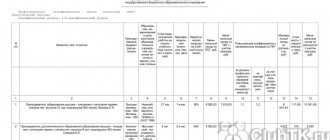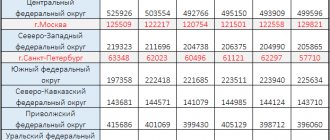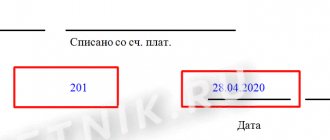Components of wages
What does salary consist of?
Stimulation of employee work is carried out financially, and successes achieved in work can be paid separately. In order for an employee to work tirelessly, and for the result of a job well done to be additionally rewarded, the employer must clearly explain for what merit additional payments are made.
That is, the motivation for excellent performance of job duties must be known to the employee.
According to labor legislation, remuneration is the same concept as wages, that is, the latter is remuneration for professional activity, directly dependent on the level of qualifications, as well as the complexity and quality of the work.
Various compensations, bonuses and additional payments are additional payments that also contribute to material incentives for the employee’s work.
The salary structure includes the following parts:
- Basic. This is the main part of the salary.
- Compensation.
- Additional incentive payments.
All these components make up the wages of an employee carrying out labor activities in accordance with an employment contract.
Benefits, vacation pay and travel allowances: included or not
The basic salary includes additional payment for the time the employee is on a business trip, as well as annual paid leave, in accordance with Chapter 19 of the Labor Code. The salary does not include compensation for travel expenses, such as hotel payments, travel costs, meals, etc. Vacation pay is paid based on average earnings for continuous work during the 12 calendar months preceding the month the vacation starts.
According to Article 129 of the Labor Code of the Russian Federation, payments not related to wages, for example, from extra-budgetary funds, which include various types of benefits, including disability benefits, maternity benefits, are not included in the calculation of wages.
What is basic salary
The amount of this payment, based on the requirements of legislative acts, cannot be lower than the minimum subsistence level. This is the basic part, which represents the basis of the salary.
In general, its calculation cannot in any way be influenced by the quantity of goods sold, the profit received by the enterprise, the volume and quality of products produced, and other criteria. The basic component is the main time worked by the employee, as a rule, this is the official salary or tariff rate.
When determining the payment of the basic part of the salary to employees of the enterprise, the following is taken into account:
- employee qualifications;
- complexity of production tasks;
- the amount of functionality assigned to the employee.
The employer does not have the right to discriminate when calculating the main part of earnings. Direct payment must correspond to the parameters of the work.
That is, having worked a certain amount of time at the enterprise, the employee has the right to at least a payment in the amount of the established salary or tariff.
Legal regulation
FZ-90 made significant amendments to Art. 129 of the Labor Code. As a result, wages and salaries are now used by the legislator as synonyms.
According to the official definition, wages are remuneration for work, which indicates a remunerative legal relationship between employer and employee. At the same time, wages indicate precisely the labor format of the relationship and distinguishes it from the civil law format (in the latter case, wages are not paid, but we are talking about the price of the contract).
Wages are established by agreement of the parties and are fixed in the employment contract (based on Article 135 of the Labor Code). But when determining the size of the salary, the employer should take into account the minimum wage established by the state, below which it is not allowed to fall.
The legal basis of wages, its form, terms and payment procedure are determined by the Labor Code. The essential features of wages, taking into account the provisions of the Labor Code governing them, are the following:
- Timely payment of wages is the employer’s responsibility under Art. 22, 56 Labor Code.
- Wages are paid to the employee for individual work on a systematic basis.
- Wages for an employee performing a certain labor function (in particular, work in a position or profession) is one of the main rights of the employee under Art. 21 Labor Code.
- The amount of wages in terms of the maximum value is not limited in any way and is determined on the basis of current official salaries or tariff rates.
Wages mean a certain amount of money, but it is also possible to pay part of it in kind by agreement with the employee in the amount of no more than 20% of total earnings.
The amount of an employee’s salary is influenced by a number of factors: his level of education, qualifications, work experience, length of service, rank, duration of the shift assigned to him, geographical working conditions, etc.
Wages are responsible for a number of important economic functions, including economic reproduction, stimulating workers to work, regulating the labor market, etc.
About compensation payments
Compensation payments as part of wages
These payments also relate to wages and represent a variable component of the employee’s salary. It depends on working conditions and employer guarantees. These are payments that do not depend on additional remuneration if the work is performed in fact, as well as on production tasks completed in full.
Based on the internal regulation of compensation accruals, these accruals are carried out. Basically, this directly concerns motivating pay for work. In general, a list of these payments is determined at the legislative level, that is, these include:
Time payment
With time-based wages, accruals are made based on the quality and quantity of actual time worked. The calculation also takes into account the working conditions and qualifications of the employee.
Conventionally, the time-based form of earnings can be divided into two subsystems. The first involves determining the amount of wages by calculating the rate payable for one hour of work. That is, earnings will be calculated on an hourly basis.
The second system is premium time-based. In this case, the calculation is made in such a way that time-based payment is taken as the basis, but taking into account possible bonuses that characterize the qualitative and quantitative characteristics of the work. What else does the payroll structure include?
What are incentive payments?
This component of wages is not constant, its indicator is a variable value, that is, it may or may not be paid by the employer. It all depends on how the employee completed the production task, what efforts he put in to get the perfect result.
This part of the payments is in no way subject to regulation by law. That is, it depends on the decision of the management of the enterprise, and if the organization has a wage fund and bonuses, then the latter can always be distributed at the discretion of the employer.
Work-motivating payments are accrued based on the work schedule, that is, if the manager can pay them, then the employee can also demand them if the plan is fulfilled efficiently and on time.
It can be understood that payments stimulating the employee’s work also fall under the motives characterizing the qualifications of labor. This is also an incentive to achieve exactly the kind of results that are aimed at productivity and improving the quality of the work process, while calculating the official salary is not enough.
The purpose of these payments is to stimulate the work of employees, which is aimed at improving qualifications and reducing the turnover of the enterprise’s personnel.
Incentive payments (additional payments, allowances, bonuses, etc.)
The procedure and amount of incentive payments are established by local regulations or collective agreements of the organization. Since incentive payments are included in the additional part of the salary and are not mandatory, they can be accrued at the will of the employer.
Local acts of the organization indicate specific indicators , upon fulfillment of which incentive payments should be accrued. If such payments are specified in the employment contract as components of wages, then the employer does not have the right to refuse to accrue them.
The main types of incentive payments are considered to be:
- various types of surcharges and allowances;
- bonuses;
- other incentive payments.
Attention
The amount and procedure for calculating incentive payments to employees of state and municipal institutions is established on the basis of the list of payments for this category of employees in accordance with Order of the Ministry of Health and Social Development dated December 29, 2007 No. 818.
Additional payments and allowances
Additional payments and allowances are stimulating in nature and are awarded to the employee for special merits in work and high professional qualities. Their goal is to arouse interest in further development in their work activities. Can be installed when:
- having higher qualifications, for example, an academic degree;
- long work experience and length of service;
- special professional skills;
- performing particularly important work;
- for the safety of information that has a special secret.
Additional payments or allowances can be paid in a fixed amount of money, as a percentage of the salary, or calculated based on the tariff rate.
Employee bonus
The bonus is calculated on the basis of an assessment of the quality of work , for the employee’s achievement of special indicators in the performance of work duties. According to the provisions of the letter of the Ministry of Labor of Russia dated September 21, 2016 No. 14-1/-911, bonuses can be paid for any period longer or shorter than a working month.
Payments are made on the basis of local acts of the organization. In the regulations on the procedure and amount of bonuses, it is advisable to indicate:
- positions of employees who are entitled to payment;
- amounts and conditions for accrual;
- frequency of accrual.
Please note:
The bonus regulations indicate the exact date of payment or a certain period for accrual, for example, the 15th day after the reporting period. If the bonus is calculated based on the results of the working year, then you can specify the month in which the payment will be made.
Comments Showing 0 of 0
About the bonus system
Premium system at the enterprise
In order to further motivate employees, the company is introducing a bonus payment system. Bonuses are paid as a reward for impeccable and high-quality work. The bonus payment system itself is divided into the following components:
- Remunerations included in the total payment for the performance of labor functions. Any employee has the right to receive this money, and if he completes production tasks on time and without comments on quality criteria. If opposite circumstances arise, then the employee is not entitled to receive bonuses.
- Additional incentives, about which nothing is stipulated in the regulatory documents on stimulating an employee when performing production tasks. This is the initiative of the leader himself.
All bonuses are paid based on the opinion of the employer if the employee flawlessly carries out production assignments and also achieves success in the professional field. There is no obligation on the part of the management of the enterprise to make such payments; this is the initiative of the latter.
Components of average earnings
In practice, it also happens that the manager uses some tricks when paying bonuses and other incentive payments. Often, only the basic salary is simply paid, but this is not correct, and such actions are illegal.
How the average monthly salary is calculated is established by labor legislation; in connection with this aspect, when calculating wages, the employer should pay attention to:
- Payroll is actually calculated for the accounting year.
- How much time was worked per month? A month is the calendar duration of working time starting from the 1st and ending with the 30th or 31st; as an exception, only February is considered, it has only 28 calendar days.
For example, an employee performed his functional duties in full for all 12 months, while he did not go on sick leave or quit for personal reasons without pay. That is, it turns out that wages are calculated based on the indicator paid for the year divided by 12 months.
Average monthly salary
There are often cases when an employer resorts to tricks when making payments or providing information on them. Often, only the salary part is taken into account, and additional payments of various types are not taken into account. Such actions, of course, do not comply with established legislation.
Article 139 of the Labor Code of the Russian Federation regulates the calculation of the average monthly salary. In this regard, when determining the average monthly salary, the manager must take into account:
- Actual accrued payments for the last year.
- Actual hours worked during each month.
About basic and additional wages
What is basic and additional salary?
The basic salary can be considered the money paid to the employee for the fact that work has been performed in full.
The basic part includes:
- payments for a specific area of work;
- payment for work on holidays or weekends, accrual is made at double the tariff rate or official salary;
- awarding bonuses for special labor achievements, fulfillment of production tasks and other merits related to the employee’s work activity;
- additional payment for harsh climatic conditions, for example, for work in northern or Ural climates;
- payments for work that was carried out in excess of the required working time, that is, the employee remained to complete the production task after the main work.
Tariff system of remuneration
Many companies use tariff systems for remunerating employees. As follows from the provisions of Article 143 of the Labor Code of the Russian Federation, tariff wage systems are wage systems based on a tariff system of differentiation of wages for workers of different categories. At the same time, it is necessary to take into account that only tariff systems of remuneration are directly provided for by the Labor Code.










